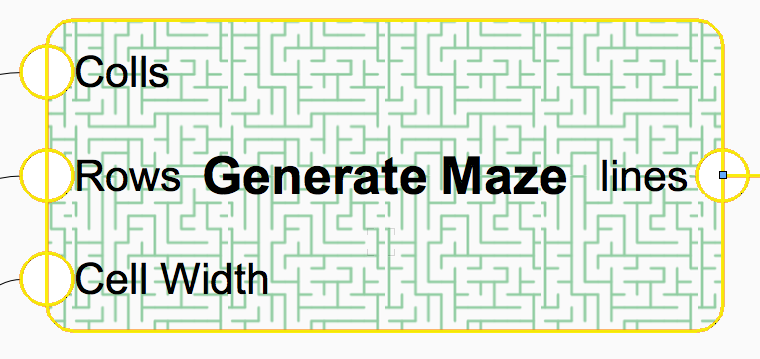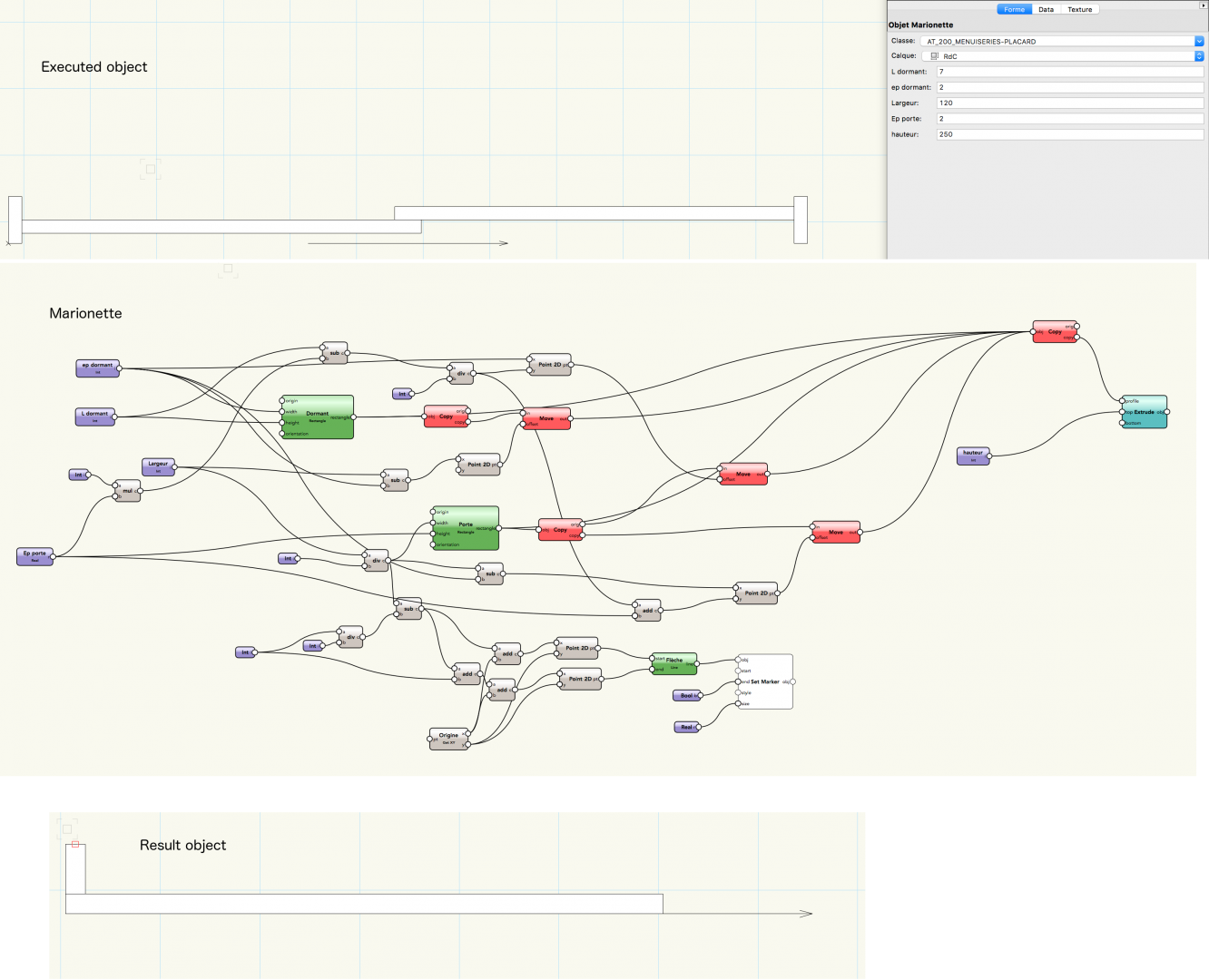Search the Community
Showing results for tags 'marionette'.
-
Hello dear forum members, I am only dealing with VW Marionette Tool recently, it seems to be a good tool but the Tutorials are too few. My questions • Is it possible to insert symbols? • It is possible to manipulate 3D components in length • Is this when 3D components lie side by side and touch each other, which I change all in length and the positions again fit so that the components touch again. Thanks for Reading HerrGohlem
-
Using a worksheet and a marionette network, I can create 61 circles (one rank of organ pipes) with spacing based on a percentage of their diameters. I'm trying to figure out how to create number labels for the pipes. I want the largest circle to be "1" and so on with the label using the same center as it's circle. Pipe Labeling.vwx
- 4 replies
-
- marionette
- worksheet
-
(and 1 more)
Tagged with:
-
-
Hello, I'm a beginner in Marionette. I succeeded in creating an hybrid object to parameter different sizes and aesthetic of a sliding closet door. However i have a problem if i want to convert the marionette in a result object i can edit as i want. All my geometry is designed based on a bottom left point, with copy and move of rectangles. But when I use the command "create a result object" it appears that all the copies don't move anymore. I joined a picture to show. In a second time i would like to use this object as a symbol to insert it in walls. Manually it works, but i would like that the result object can automatically be inserted. Is it possible ? Thanks for your help to improve this object, Nicolas
-
I am trying to determine what parameter to input into the Create Field node/FldType to create the different types of fields (i.e. integener, boolean, text, and the multiple formats of numbers).
-
Hi, I have a problem using Planar Boolean (Subtraction) in a wrapped script in which the original components are not deleted. I've seen this same topic in the forum but, because I cannot find the file attachments I cannot access to the solution. I have attached the file with the script (Marionette object). The subtraction operation happens in the Matboard wrapped script and it's supposed to generate a hole in the matboard through which the picture is supposed to be visible. I will appreciate if somebody can provide the solution. --Carlos picture.vwx
-
In the current shipped VW Versions (2017 Release & 2016), the Set Layer node is a little flaky. I've attached an updated Set Layer node that is much more user friendly and behaves more appropriately and aligned with the rest of the default content. I hope to have this updated with our shipped content soon. SetLayer_v2.vwx SetLayer_v2_v2016.vwx
-
I'm having a problem with marionette. I want to make a series of rectangles. I should be able to first enter how many rectangles I want, then each rectangle should get a different length. Is this possible?
-
I really like the functionality of the new Slider node in Vectorworks 2017. It has a good amount of flexibility. Here are a few examples of it used for Angle (-90 to +90 range), Angle (1-360 range) and Percent (0-100). (@MarissaFis there a trick to putting an arrow marker onto one end of a line in Marionette? I thought it would be easy using the Attributes node but that doesn't work. Searching around I couldn't easily find a way to do it....) Kevin Sliders.vwx
- 4 replies
-
- 1
-

-
- marionette
- 2017
-
(and 1 more)
Tagged with:
-
Hey guys! I'm looking for users who have 2017 installed to test a network for me... It's the file I was using before for image processing. It should be cross platform, so both Windows and Mac users are welcome to give it a go, but you MUST use VW 2017. This network WILL NOT work in 2016. Attached is a file with a test image and a network. My suggestion would be to not change the test image, but if you really, really want to give it a go, make sure it's still a small image. I would recommend under 100x100 pixels - this network takes a while to run if you use a large file. (One of mine took over a day...) Some additional information to be aware of: 1) This network will install an external python library from the web. The library will be installed into your userfolder/Python Externals. You can delete this at any time and it should not affect how VW runs. 2) This network will create a 'temp' folder in your user folder. This folder is created to store the image that is exported from VW, then imported later. This is done because the Pillow commands require an actual image time to query. You can delete this later, if you would like. Every time you run the network, the image will be re-saved to this location, unless you edit the code. 3) Again, DO NOT use a large image. I promise, there's a chance you would regret it. So I'll end this with a 'use at your own risk' clause, and I would suggest saving/closing any important files you have open in VW in the off chance that you encounter a crash/hang/whatever. Please tell me if you encounter a crash! Also, I'll field any questions you have. If you want more info before giving it a go, let me know, and I will do my best to answer them. This is a very limited script at the moment, I still have a lot more in mind. I just want to make sure it goes well small-scale before I go big ImgProcessing.vwx
-
I'm curious to know if its possible to display values generated by a Marionette network in the OIP. I've experimented a little with the Marionette OIP controls and I am able to display static info using Marionette.WidgetType.TextStaticParam. I've created a couple of simple custom nodes for Maker Info and Object Name and I'm able to essentially trick Marionette into displaying this info for Marionette Objects (image below). But what if I wanted to display the area of an object generated by a Marionette Object in a static manner like what you see with a regular VW object. Is this possible? Is there a way to feed a variable from a network back to the OIP? I know I can easily display something like this as text on the drawing but I'd like it in the OIP. Thanks, Kevin OIP Example.vwx
-
I used Fundamentals this am on behalf of a client who has a strong interest in trying Marionette to replace the many Vector Scripts he has created and used for many years. Sadly Marionette is not available in Fundamentals. Given that you have the ability to do scripts in that version would it not be logical to have Marionette there as well.
- 1 reply
-
- marionette
- missing
-
(and 1 more)
Tagged with:
-
Marionette was introduced with the intention that non-programmers could learn to use it without having any previous programming knowledge. Personally, I have not found that to be the case. This may be partially because Marionette is still very new and not fully documented, but even if it were, it seems like Marionette's current implementation requires quite a bit of programming knowledge as evidenced by many of the threads in this Marionette forum. It is not in any way user-friendly or intuitive for the 'programming newbie'. Watching any of the thousands of tutorial videos on Grasshopper or Dynamo won't get you very far with Marionette. The written content and presentation on the Vw Dev Wiki has always been intended for a target audience of developers and programmers. It requires a good working knowledge of VS and Python to understand any part of it, and probably most Vw users have no need to ever visit it. In addition to being very 'code heavy', the Dev Wiki is also very 'text heavy', without many pictures or diagrams. Graphically, it is the exact opposite of what the training material for a graphical scripting language like Marionette should look like. Just providing a single-page listing the name and simple description of each node is not enough (especially since it's the same info that you get by clicking on the Node's OIP 'Description' button). We need to have examples of how to use each node including what are its accepted inputs and its expected outputs. The Marionette - Implement a Node page, which I believe is intended to be 'Introductory 101' level, is very heavy into required programming with lots of Python code. Personally, I did not find that page to be very intuitive or helpful; I became lost before I even started. The six Introductory video tutorials posted here are a good start - and certainly more of these videos will be welcome, but... What I think is needed is a separate, dedicated 'Marionette Primer' website along the lines of the Dynamo Primer. Simply putting more info on the Dev Wiki is not the best way to further expand knowledge about Marionette.











